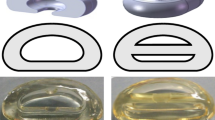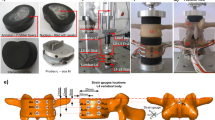Abstract
Introduction
The elastomeric, monobloc disc prosthesis (Cadisc™-L, Ranier Technology, Cambridge, UK) aims to preserve biomechanics of an implanted spinal motion segment.
Study design
This study presents the findings of an in vitro investigation on the effect of implantation of Cadisc™-L. Compressive stiffness, flexion stiffness at 10, 20, 30 and 40 Nm and the instant-axis-of-rotation (IAR) loci are compared before and after implantation of a MC-10 mm-6° Cadisc™-L.
Methods
Fresh frozen human monosegmental lumbar spines (n = 8) were prepared, potted and tested in an environmentally controlled chamber to simulate in vivo conditions. Specimens were preconditioned by loading to 500 N for 30 min. Compressive stiffness of the specimen was determined by applying pure compression of 1 kN at 250 N/s via a loading roller positioned at the central loading axis (CLA). The roller was then offset 12.5 mm anterior of the CLA and the loading regime repeated to test specimens in flexion. Bending moments were calculated from the applied load and corresponding flexion angle. The IAR locus was tracked by a motion-tracking camera.
Results
Compressive stiffness was reduced by 50 % (p = 0.0005), flexion stiffness was not statistically significantly reduced (40 % reduction, p > 0.05). IAR locus maintained a ‘horizontal figure of eight’ characteristic. Change in the locus width in the AP plane of 6.4 mm (p = 0.06) and height in the SI plane of 1.3 mm (p = 0.44) were not significant. The centroid was displaced 4.44 mm (p = 0.0019) and 5.44 mm (p = 0.025) at 3° and 6° flexion, respectively.
Conclusions
Implantation of Cadisc™-L caused a reduction in axial stiffness, but maintained disc height and flexion stiffness. IAR loci remained mobile without large displacement of the centroid from the intact spine position.






Similar content being viewed by others
References
Waris E et al (2007) Disc degeneration in low back pain: a 17-year follow-up study using magnetic resonance imaging. Spine 32(6):681–684
Tanaka N et al (2001) The relationship between disc degeneration and flexibility of the lumbar spine. Spine J 1(1):47–56
Burton AK et al (1996) Lumbar disc degeneration and sagittal flexibility. J Spinal Disord 9(5):418–424
Mimura M et al (1994) Disc degeneration affects the multidirectional flexibility of the lumbar spine. Spine 19(12):1371–1380
van Ooij A et al (2007) Polyethylene wear debris and long-term clinical failure of the Charite disc prosthesis: a study of 4 patients. Spine (Phila Pa 1976) 32(2):223–229
Kurtz SM et al (2007) Polyethylene wear and rim fracture in total disc arthroplasty. Spine J 7(1):12–21
Ranier (2010) Cadisc™-L product description. [cited 2010 26-04-10. The manufacturer’s product information for Cadisc™-L device]. Available from: http://www.ranier.co.uk/index.php?public//products/cadisc-l
Gwynne JH, Oyen ML, Cameron RE (2010) Preparation of polymeric samples containing a graduated modulus region and development of nanoindentation linescan techniques. Polym Testing 29(4):494–502
Adams MA, Dolan P (1991) A technique for quantifying the bending moment acting on the lumbar spine in vivo. J Biomech 24(2):117–126
Thompson JP et al (1990) Preliminary evaluation of a scheme for grading the gross morphology of the human intervertebral disc. Spine (Phila Pa 1976) 15(5):411–415
de Visser H, Rowe C, Pearcy M (2007) A robotic testing facility for the measurement of the mechanics of spinal joints. Proc Inst Mech Eng [H] 221(3):221–227
Adams MA (1995) Mechanical testing of the spine. An appraisal of methodology, results, and conclusions. Spine (Phila Pa 1976) 20(19):2151–2156
Oxland TR et al (1992) The effect of injury on rotational coupling at the lumbosacral joint. A biomechanical investigation. Spine (Phila Pa 1976) 17(1):74–80
Reuleaux F (1876) Kinematics of Machinery. MacMillan and Co, New York
Hansson T, Roos B, Nachemson A (1980) The bone mineral content and ultimate compressive strength of lumbar vertebrae. Spine (Phila Pa 1976) 5(1):46–55
Heuer F et al (2007) Stepwise reduction of functional spinal structures increase range of motion and change lordosis angle. J Biomech 40(2):271–280
Hitchon PW et al (2005) Biomechanical studies of an artificial disc implant in the human cadaveric spine. J Neurosurg Spine 2(3):339–343
Kotani Y et al (2006) Multidirectional flexibility analysis of anterior and posterior lumbar artificial disc reconstruction: in vitro human cadaveric spine model. Eur Spine J 15(10):1511–1520
Rousseau MA et al (2006) Disc arthroplasty design influences intervertebral kinematics and facet forces. Spine J 6(3):258–266
Gertzbein SD et al (1985) Centrode patterns and segmental instability in degenerative disc disease. Spine (Phila Pa 1976) 10(3):257–261
Gertzbein SD et al (1986) Centrode characteristics of the lumbar spine as a function of segmental instability. Clin Orthop Relat Res 208:48–51
Pearcy MJ, Bogduk N (1988) Instantaneous axes of rotation of the lumbar intervertebral joints. Spine (Phila Pa 1976) 13(9):1033–1041
Seligman JV et al (1984) Computer analysis of spinal segment motion in degenerative disc disease with and without axial loading. Spine (Phila Pa 1976) 9(6):566–573
Ogston NG et al (1986) Centrode patterns in the lumbar spine. Baseline studies in normal subjects. Spine (Phila Pa 1976) 11(6):591–595
Acknowledgments
This work was supported by Engineering & Physical Sciences Research Council grant, and Ranier Technology Ltd.
Conflict of interest
Donal McNally is a member of the Scientific Advisory Board of Ranier Technology Ltd. Scott Johnson is an employee of Ranier Technology Ltd.
Author information
Authors and Affiliations
Corresponding author
Rights and permissions
About this article
Cite this article
McNally, D., Naylor, J. & Johnson, S. An in vitro biomechanical comparison of Cadisc™-L with natural lumbar discs in axial compression and sagittal flexion. Eur Spine J 21 (Suppl 5), 612–617 (2012). https://doi.org/10.1007/s00586-012-2249-4
Received:
Revised:
Accepted:
Published:
Issue Date:
DOI: https://doi.org/10.1007/s00586-012-2249-4




